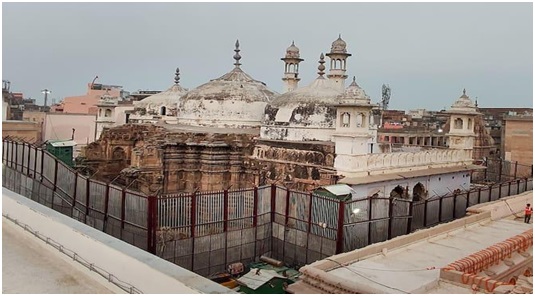Incremental injustice (The Hindu)

- 07 Aug 2023
Why in the News?
Recently, the Varanasi District Court issued an order for the Archaeological Survey of India (ASI) to conduct a survey of the Gyanvapi mosque.
Background:
In 1984, around 558 Hindus assembled in Delhi to hold the first religious parliament. During this gathering, they made a unanimous decision to initiate a nationwide campaign for Hindus to assert their rights over the sacred shrines located in Varanasi, Mathura, and Ayodhya. The movement gained momentum after the Ram Janma Bhumi-Babri Masjid dispute in 1990. Although the initial call was to claim about 3000 mosques in the mentioned areas, Hindu religious groups focused their efforts on two particular mosques: (1) The Shahi Idgah mosque, situated adjacent to the Lord Krishna temple in Mathura, and (2) The Gyanvapi mosque, located next to the Kashi Vishwanath temple in Varanasi.
What is Gyanvapi Mosque Dispute?
Historical Background:
- There is a prevailing belief that the Gyanvapi Mosque was constructed in 1669 under the rule of the Mughal Emperor Aurangzeb. The mosque is said to have been built on the site where the ancient Vishweshwar temple once stood.
- According to Saqib Khan's book 'Yasir Alamgiri', it is mentioned that Aurangzeb ordered Governor Abul Hassan to demolish the Vishweshwar temple in 1669, paving the way for the construction of the Gyanvapi Mosque.
Judicial Intervention in the Gyanvapi Mosque Dispute:
- The legal case pertaining to the Gyanvapi mosque dates back to 1991 when three individuals, including Pandit Somnath Vyas, a descendant of the Kashi Vishwanath temple priests, filed a lawsuit in the civil court of Varanasi. Their claim asserted that Aurangzeb had demolished the original Lord Vishweshwar temple and constructed a mosque in its place, urging that the land should be restored to them.
- In 2021, five women lodged a petition in the same Varanasi court, seeking permission to worship at the temple of Mother Gauri. Consequently, the court appointed a commission to investigate the present status of the Makeup Gauri Temple.
- As part of the commission's task, the court instructed the survey report to be documented through video-graphing, covering the idol of Makeup Gauri and the Gyanvapi complex.
- This development sparked controversy as questions arose about the impartiality of the court-appointed commissioner representing the Muslim side in the survey process.
Arguments From Hindu Side:
- Vijay Shankar Rastogi, representing the Hindu side, presented a map of the entire Gyanvapi complex as evidence in court.
- The map indicates the presence of Hindu deities' temples beyond the mosque's entrance, along with the Vishweshwar temple, Gyankoop, the big Nandi, and the basement of the Vyas family.
- There has been a contentious issue regarding the survey and videography of the basement in question.
Arguments From Muslim Side:
- The Muslim side contends that the dispute cannot be adjudicated under the Religious Places Act of 1991.
- According to Section 3 of the Places of Worship (Special Provisions) Act, 1991, it is forbidden to convert a place of worship, including its precincts, into a place of worship of a different religious denomination or a different class within the same religious denomination.
- Section 4(2) of the Act stipulates that all ongoing litigations, appeals, or other proceedings concerning the alteration of the place of worship (which were pending until August 15, 1947) shall be terminated after the enactment of this Act, and no new actions can be initiated on such cases.
- However, legal action can be pursued if the alteration in the nature of the place of worship occurred after the cut-off date of August 15, 1947 (after the act came into force).
- For instance, the disputed site of Ayodhya (Ram Janmabhoomi-Babri Masjid) was exempted from the Act.
About Archaeological Survey of India (ASI):
- The Archaeological Survey of India (ASI) is a government agency responsible for preserving, conserving, and excavating archaeological sites and monuments in India.
- It was founded in 1861 and established by ‘Alexander Cunningham’
- It operates under the Ministry of Culture and it’s HQ is in Delhi.
- ASI's main objective is to protect and maintain India's rich cultural heritage, including ancient temples, forts, caves, sculptures, and archaeological remains.
- The organization conducts excavations and research to uncover historical insights and restore significant monuments to their original state.
- ASI plays a crucial role in promoting tourism and fostering a deeper understanding of India's history and cultural diversity.
- Its efforts contribute significantly to preserving invaluable historical treasures for future generations.
- It also regulates the Antiquities and Art Treasure Act, of 1972.
Places of Worship (Special Provisions) Act, 1991:
The Act prohibits converting any place of worship and ensures the maintenance of its religious character as it existed on August 15, 1947. It applies to the entire India, except Jammu and Kashmir.
- Bar of Conversion of Places of Worship:
- No person can convert any place of worship or its religious denomination into another religious sect or section of the same denomination.
- Declaration on Religious Character and Jurisdiction Bar:
- The religious character of a place of worship on August 15, 1947, remains unchanged.
- Pending suits or proceedings related to religious conversion shall abate, and no new suits can be filed after the Act's commencement.
- Exceptions include ancient and historical monuments, settled disputes, conversions before the Act, and barred challenges under limitations.
- Exemption for Ram Janma Bhumi-Babri Masjid:
- The Act does not apply to the Ram Janma Bhumi-Babri Masjid in Ayodhya, Uttar Pradesh, and related suits or proceedings.
- Punishment under the Act:
- Violation of Section 3 results in imprisonment up to three years and a fine.
- Attempting or abetting the offence carries similar penalties as provided under relevant IPC sections."
